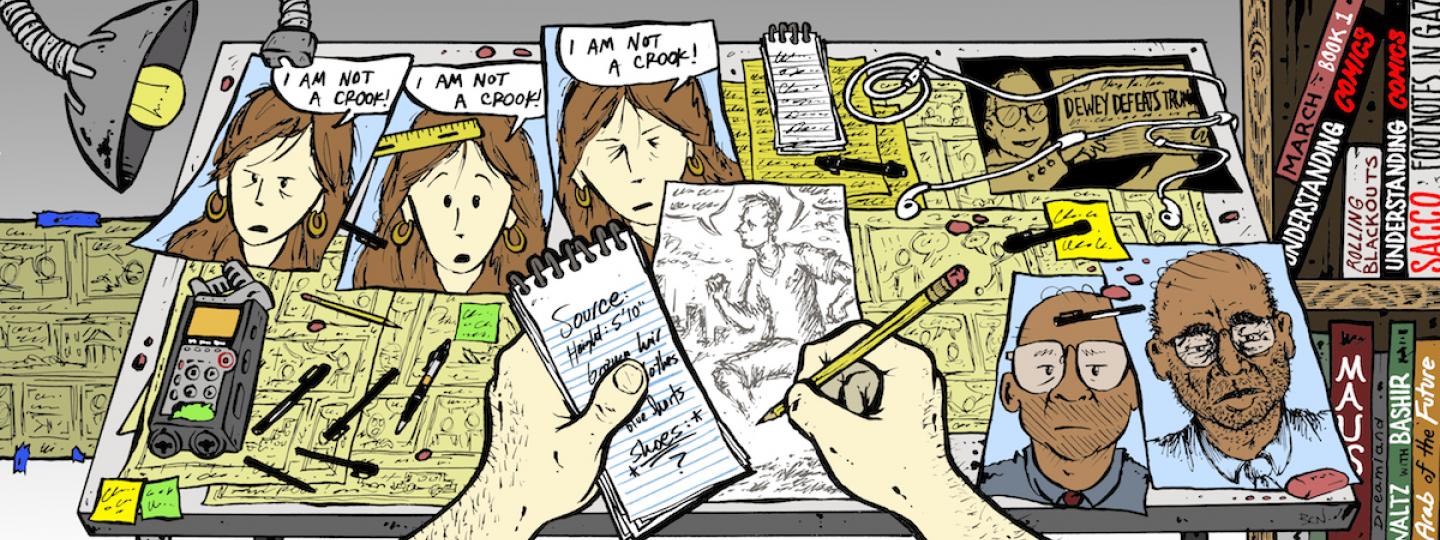Pairing illustration with news gathering is not a new idea.
More than a century ago, the Illustrated London News hired artistic journalists, like its “Special War Artist” Melton Prior, to draw global events. Over the past few years news organizations both national (The New York Times Magazine) and local (WCPO in Cincinnati) have used comics to tell true stories.
But creating non-fiction comics can be tricky. It certainly has been for me. While reporting for a newspaper in Missouri, it took several of us months to get my first piece of comics journalism off the ground, because of a host of formatting, aesthetic and ethical issues I simply hadn’t anticipated.
To better understand the medium, I interviewed a dozen journalists, artists and editors about their best practices for creating comics journalism. Based on their responses, here are seven questions every artist and editor should ask.
Some quotes were condensed for clarity.
1. Why should this story be drawn as a comic?
Several journalists pointed to three types of stories that work especially well as comics: “wonky” policy stories, sensitive investigations and history comics.
“Illustration can be a very, very powerful form of storytelling,” said Carrie Ching, who produced the animated video that accompanied the International Consortium of Investigative Journalists’ Panama Papers project. Part of illustration’s power comes from the fact that it can make dense stories both entertaining and accessible. The Panama Papers investigation was both wonky and sensitive, but four minutes of animation coherently summarized the investigation’s major findings. “Like sugar-coating a vitamin,” Ching once wrote.
If journalists, editors and their readers are new to illustrated journalism, drawing a historical event can be a good introduction to the medium. “It's lower stakes,” said Josh Kramer, a comics journalist who edits the anthology The Cartoon Picayune. “Everybody's dead, and you don't have to worry about mangling the quote of somebody that you talked to.”
2. What space does this story need, both online and in print?
Photos can be cropped, words re-arranged, but finished art isn’t as malleable.
“I want to be hooked up with a graphic designer, or get the tech specs on something in the beginning,” Kramer said. It’s important to lock down the shape and size of the final piece. Re-designing the space late in the process can necessitate re-drawing the art, which is both time-consuming and expensive.
3. How are sources going to be drawn, and how will that impact how readers receive them?
This is a biggie.
“I’ve tried to draw more representationally over time,” said reporter Joe Sacco, who arguably invented modern comics journalism. “It doesn’t have to be that way!”
The choice between realistically drawn characters and more cartoony ones is not just aesthetic; how abstractly a journalist draws his or her sources may influence how readers perceive them. In the book "Understanding Comics," the comics theorist Scott McCloud argued that the more abstractly characters are drawn, the more readers project themselves onto them. If this is accurate, a comics journalist could influence what sources a reader empathizes with based on how realistically they’re depicted.
Drawing people of different races is also complex. “There is an issue with both comics journalism and political cartooning, where everything you draw is kind of symbolic and representative,” said Jen Sorensen, a 2017 Pulitzer finalist for editorial cartooning.
“Going back a lesson from my days as an anthropology student, there are 'marked' and 'unmarked' categories of people,” she wrote later. “A white male character is 'unmarked' in that he can be read as a universal human being with no special significance attached. A character who is a person of color and/or female tends to be read as representative of their demographic”.
Drawing characters too generally, however, can whitewash them and strip them of their defining characteristics. “You need to strive for as much diversity as possible,” Sorensen said, “while also being mindful of how things might be read symbolically.”
Recommended webinar: Animation and Storytelling for Journalism
4. How are we going to present visual details we’re missing, details we may still need to draw?
Here is a situation you may encounter: You have to draw a source walking down a street in an important scene. You know what the source looks like, and you have reference photographs of the street, but you don’t know the brand of shoes the source was wearing.
The journalist John Hersey famously said: “The writer must not invent. The legend on the license must read: NONE OF THIS WAS MADE UP.” But can the comics artist make something up, even if it’s a detail as small as the brand of a shoe?
Most of the journalists interviewed said: Yes. Sort of.
OPTION 1: Sorensen was one of several artists who said missing information could be filled in with details representative of that time.
OPTION 2: Kramer pointed out that, in the case of shoes, artists could obscure the brand by drawing them abstractly and generically.
Showing a specific shoe brand isn’t crucial, Ching said. “Unless the story is about the brand of shoes.”
5. Could a source’s facial expression artificially manipulate how a quote is interpreted?
Say you quote a public official in a traditional print article saying: “I am not a crook.” What verb do you place after that quote? “I am not a crook,” she claimed? Or: “I am not a crook,” she argued? Or: “I am not a crook,” she pleaded?
Each verb has a different impact on how a reader perceives the quote, which is why some editors say the neutral verb “said” is the ideal choice.
The equivalent conundrum for artists is how to draw a speaking source. “Facial expressions … can really change the reader's perception,” comics journalist Andy Warner said. “I think that is actually far bigger of an ethical pitfall than depictions of background or scene.”
As a solution, Warner said he sometimes has tried to find a “benign middle ground,” by drawing sources with expressionless and “boring” faces.
6. How can someone without a visual background prepare to edit comics journalism?
Mara Joustra, an editor and co-founder of the graphic journalism website “Drawing the Times,” recommended editors without a background in art take drawing classes if they want to oversee comics journalism. That instruction would both introduce them to the unique “language of image,” she wrote in an email, while also helping them understand just how long drawing a single panel can take.
She also said editors should check out McCloud’s book "Understanding Comics," as well as his TED Talk, “The Visual Magic of Comics.”
7. What do our readers know (and not know) about comics journalism?
“Making drawings – it's explicitly not reality,” said the artist Ronald Wimberly, who has created comics journalism for The New Yorker. “There's no pretense to reality.” Others agreed that readers automatically understand the subjective nature of illustration.
That said, news organizations sometimes include paragraphs at the top of their comics to explain both their reporter’s choices and the medium in general. Two short examples can be found here and here.
These seven questions will no doubt lead to other doozies. (Like: If an interview is translated from another language, should you draw the entire translation process? Or just put what the interpreter said in a word bubble over the original speaker?)
The good news, however, is that good journalism remains good journalism. The ethics that guide reporting in other media can still be applied here.
Comics editors should “bring to it all of the demands that you bring to any other piece of journalism,” Metropolitan Books editor Riva Hocherman said. (Hocherman has edited several major books of comics journalism, including Sacco’s "Footnotes in Gaza" and Riad Sattouf’s "The Arab of the Future").
“What am I looking for when I'm working on a script?” Hocherman said. “It's not so very different from the process of working on a traditional book.”








